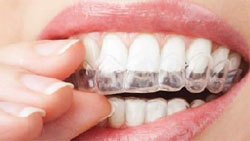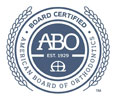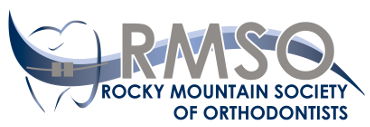Does Invisalign work?
“How effective is Invisalign?”
- Passing Rate of cases treated Invisalign v. Braces: 27% lower (2)
- “Deficient in its ability to correct overjet & occlusal contacts” (2)
- Mean percentage of simple tooth movement goal (30 patients moving one incisor 1mm) only 57% (4)
- Minimal Improvement in occlusal score based on Board standards from 47 to 36.4 (0 is ideal) (4)
- “Negative change (2.5x worse after treatment) in posterior occlusal contacts with Invisalign” (7)
- “Treatment with Invisalign aligners had adverse effects on posterior occlusal contacts” (7)
- “Invisalign did not treat malocclusions as well as braces” (7)
Will you accept a meager 41% or less "success" result for your family?
Are you being offered what is best for you or your family? (3)
*All studies and articles referenced can be found in The American Journal of Orthodontics & Dentofacial Orthopedics (AJO-DO), a publication of the American Association of Orthodontists (AAO).
Today’s practitioners have many tools to provide patients with beautiful and functional smiles; probably the most advertised has been the use of three dimensional laser scanners to digitize whole arches of teeth for use in computer software that essentially morphs teeth into alignment on the computer. Clear plastic trays are then fabricated incorporating these incremental movements that match the imaginary digital movements. Although there are a growing number companies providing this service, the process has become synonymous with Align Technology’s tray system known as Invisalign.
When these trays are worn in sequence, the idea is that teeth will slowly move into the incremental changes represented at each interval using the resistance/flexibility of the tray materials. Of course the real question is how much movement can we get and is the movement accurate to what we want and need as doctors?
Since this technology (initially introduced only to Orthodontists) has been advertised to general dentists and directly to the public, academic leaders within the specialty of Orthodontics have expressed concerns noting that “over the last few years,[Invisalign] advertising has taken a toll on the traditional standards of Orthodontics stressing esthetics of the smile over the function of the occlusion (1).”
As a practitioner for 20 years, I was practicing when Invisalign was first introduced to Orthodontists as an adjunctive tool to treat minor cases of relapse and crowding. It was similar to other systems we used in-house (without a scanner, computer program to move teeth or a $1500 to $2000 lab bill) but allowed multiple steps to be performed in sequence without multiple impressions and lab procedures to re-set teeth in stone. As an Orthodontist introduced to Invisalign while in my residency, I tried it with others and realized the strengths and weaknesses almost immediately. In fact for years I did not know a single Orthodontist, instructor or practitioner, that felt Invisalign could ever compete with the success of braces. I think it was for that reason Invisalign really was kept as a tool for what it was designed for many years; mild crowding cases with no skeletal discrepancies and no significant malocclusions.
It was only when dentists started treating with Invisalign (after just a few weekend hours of training) that Orthodontists I knew started to give in and “accept” Invisalign knowing it wasn’t equal but not wanting to give up patients to dentists. Only this year, Invisalign reached the notoriety of having more Orthodontist cases started than dentist cases. Some young Orthodontists around me only offer Invisalign and may never even touch their patients. It has become mail-order and outsourced medicine.
Today we see Align Technologies/Invisalign working to increase profit and expand their market share by claiming they can treat more and more difficult cases and younger and younger patients (i.e. Invisalign Teen). I have seen a local competitor actually claim superior service to all and able to treat underbites, openbites, crossbites, severe crowding (extraction cases) and kids as young as ten years old with Invisalign without even offering braces, all after being in his practice for less than 2 years! I doubt he had even completed a dozen cases before advertising his prowess. Those of us that have practiced for many years and used aligners as they have developed know the literature shows Invisalign to be inferior and that many patients with even moderate crowding would still require further treatment including fixed braces, a fact confirmed in studies (1,2,7).
In a published Letter to the Editor in the Journal of the American Association of Orthodontics & Dentofacial Orthopedics (AJODO) (3), a respected Orthodontist stated what many of us had concluded:
“Despite Align Technology's claims, orthodontic treatment and Invisalign therapy are not the same thing. The misrepresentation of orthodontic treatment in the marketing of Invisalign is a disservice to our patients. It is also at odds with the mission of the AAO, the ABO, and other well-respected orthodontic professional organizations. By emphasizing Invisalign's ability to achieve straight teeth, without mentioning the importance of a functional occlusion, ideal overbite and overjet, aligned marginal ridges, and long-term stability, Align Technology has effectively reduced the role of the orthodontist from that of a “knowledgeable dental specialist and professional” to that of an “esthetician.”
This same article continued to purport that “Align Technology has blurred the distinction between general dentists and orthodontists about expertise in dental movement. By equating the experience of doctors using Invisalign to the return search list of recommended doctors found on Align Technology's website, orthodontic specialty training has been rendered inconsequential to the prospective Invisalign patient.”
Another article (7) titled “Evaluation of Invisalign treatment utilizing the American Board of Orthodontics Objective Grading System for dental casts” compared pre and post-treatment records of 135 Invisalign cases from 7 different Orthodontic practices and demonstrated a marginal improvement of scores from an average of a 47.0 OGS only down to 36.4 OGS (a 0 is considered no problems or an ideal occlusion) confirming other studies that show improvements from 20 to 40% but leaving significant issues; the most damning finding was an actual 2.5x increase in the posterior occlusal malocclusion due to bites opening leaving heavy anterior occlusion which can lead to TMD, fracture of teeth and instability of any correction.
A year later, a different study was undertaken and published in the AJODO (2) comparing two groups of 48 patients to grade the results of Invisalign patients v. patients treated with traditional braces. Results were assessed using the American Board of Orthodontics standard grading system (OGS) used for the Phase III boards (5) which has been shown to be valid and correlates with perceived subjective goals (6). The findings were rather telling: “The Invisalign group lost 13 OGS points more than the braces group on average, and the OGS passing rate for Invisalign was 27% lower than that for braces. Invisalign scores were consistently lower than braces scores for buccolingual inclination, occlusal contacts, occlusal relationships, and overjet. Invisalign’s OGS scores were negatively correlated to initial overjet, occlusion, and buccal posterior crossibite”. The authors went on to state the following very strong conclusion:
“According to the OGS, Invisalign did not treat malocclusions as well as braces … Invisalign was especially deficient in its ability to correct large anteroposterior discrepancies and occlusal contacts.”
Many Orthodontists still felt the need to offer Invisalign to provide more of what the patient wanted but also to compete with a growing field of non-accredited/untrained dentists that no longer would refer patients to specialists (citing proper case-selection) and after several more years, in 2007, the AJODO published the following benchmark prospective study,“How well does Invisalign work? A prospective clinical study evaluating the efficacy of tooth movement with Invisalign (1)”
This article detailed exactly how effective Invisalign was when focusing on accuracy of tooth movements in all planes of space:
The results of the study revealed the mean accuracy of tooth movement with Invisalign was only 41%. The most accurate movement was lingual constriction (pulling teeth back inward) but even that was only 47.1% while some movements were a dismal 18.3% (extrusion of upper teeth) 24.5% (extrusion of lower incisors), and 26.9% for tipping of lower canines. Also, rotation of canines were “significantly lower than that of all other teeth … [with] rotational movements greater than 15%, the accuracy of rotation for the maxillary [upper] canines fell significantly.” A stark conclusion from this article stated that “We [Orthodontists] still have much to learn regarding the biomechanics and efficacy of the Invisalign system. A better understanding of Invisalign's ability to move teeth might help the clinician select suitable patients for treatment, guide the proper sequencing of movement, and reduce the need for case refinement” [including finishing with braces].
Studies also have shown that age has an effect on outcome from Invisalign treatment (4). In a study published in the AJODO as recent as 2013, not only was the tooth movement goal studied, but also the effects certain age groups had on success.
The prospective study centered on movement of a single central incisor 1mm in 35 patients and the post-aligner goal was measured for movement. The summary results revealed “the mean percentage of tooth movement goal achieved was 57% overall. Linear regression modeling indicated a cubic relationship between age and tooth movement, with a decreasing rate of movement from ages 18 to 35 years, a slightly increasing rate from ages 35 to 50, and a decreasing rate from ages 50 to 70. The final decreasing trend was not apparent for women. As would be expected, the correlation was significant between the percentage of the goal achieved and the cone-beam computed tomography superimposed linear measures of tooth movement.” I can tell you from experience, braces can move incisors 2 to 3mm 100% just about every time (I can’t think of an exception short of pathology/fusion to bone).
These results also confirmed other preceding studies that state the more a tooth is tipped initially, the less Invisalign can correct; “A significant negative correlation was found between tooth movement and the measurement apex to the center of rotation”, of course this is rather intuitive for an Orthodontist and the reason we still use fixed braces.
The larger and more important question is how much quality should we sacrifice to provide a perceived improved smile? Do we align the front teeth at the expense of long-term function, possibly leaving teeth and supporting tissues at risk of damage later? Is it malpractice to line up the front teeth but leave no contact on back teeth (I would argue absolutely)? Is an acceptance of Invisalign lowering the standards of Orthodontics? Are we doctors with ethics or are we an arm of a corporate product? What is the doctor’s obligation to provide an acceptable standard of care?
I want to be clear with the pubic, my colleagues that embrace Invisalign and with my friends at Align Technologies; I serve the interests of the patients first. I hold the dental licenses and the credentials to make the decisions based on unbiased and juried (peer-reviewed) literature, based on professional experience and correspondence with other specialists and with cooperation of leaders in the field of Orthodontics, Dentofacial Orthopedics, Physics and Physiology. I am not saying Invisalign and other aligners are not effective enough to use for some patients that do not want to wear braces or for simple cases of malalignment, but I have personally seen many cases with poor/incomplete outcomes and there is a significant amount of “refinement” with braces needed in many aligner cases. This is seen in the literature and it has been continually demonstrated; Invisalign simply cannot produce results that I feel are acceptable in moderate to severe cases (to me 18% to 40% overall or 57% just to move a single tooth one millimeter are all failing grades in medicine) especially considering there is a product that can give a much greater success on average without the ill effects on the posterior occlusion.
As this trend continues, driven by significant advertising to the public, the willingness of dentists to sell a product and endless financial rewards to practicing dentists/Orthodontists that provide Invisalign (Align Technology rewards those who send more cases with free advertising and referrals), we should all consider the best interests of the patient even when they don’t understand or want to hear what may be best. If a patient chooses a lesser result and there is no damage in providing such then Invisalign or another aligner system may be a great fit. If, however, the patient wants something that has been shown to leave more of a malocclusion (even if the teeth look better), then the ethical doctor must resist the urge to collect a fee for inherently poor service.
As for me, I will continue to provide aligners to appropriate cases using the Orchestrate3D system which leaves all control directly to me from scanning, to producing models to moving teeth on my own computer and finally to producing trays in my own office lab because Orchestrate 3D was designed by Orthodontists specifically for accredited Orthodontists that refuse to out-source their patients’ care. Furthermore, I will not sacrifice a good functional occlusion for simple alignment of teeth and I do not believe other Orthodontists should do any less. We know better, the literature clearly shows us the limitations and we are bound by ethics.
1. How well does Invisalign work? A prospective clinical study evaluating the efficacy of tooth movement with Invisalign
Neal D. Kravitz, Budi Kusnoto, Ellen BeGole, Ales Obrez, Brent Agran
http://dx.doi.org/10.1016/j.ajodo.2007.05.018
2. Outcome assessment of Invisalign and traditional orthodontic treatment compared with the American Board of Orthodontics objective grading system
Garret Djeua, Clarence Sheltonb, Anthony Maganzinic
aFormer orthodontic resident.
bAssistant clinical professor; private practice, New York, NY.
cDirector of orthodontics.
http://dx.doi.org/10.1016/j.ajodo.2005.06.002
3. Letters to the editor*; Invisalign and changing relationships
Christine P Ellis, DDS, MSD
Dallas, TX, USA
http://dx.doi.org/10.1016/j.ajodo.2004.05.002
4. Variables affecting orthodontic tooth movement with clear aligners
Justin R. Chisari, Susan P. McGorray, Madhu Nair, Timothy T. Wheeler
http://dx.doi.org/10.1016/j.ajodo.2013.10.022
5. Grading System Casts Radiographs
6. Validation of the American Board of Orthodontics Objective Grading System for assessing the treatment outcomes of Chinese patients.
Song GY1, Baumrind S, Zhao ZH, Ding Y, Bai YX, Wang L, He H, Shen G, Li WR, Wu WZ, Ren C, Weng XR, Geng Z, Xu TM.
Am J Orthod Dentofacial Orthop. 2013 Sep;144(3):391-7. doi: 10.1016/j.ajodo.2013.04.018.
7. Evaluation of Invisalign treatment utilizing the American Board of Orthodontics Objective Grading System for dental casts
Scott Vincent
http://dx.doi.org/10.1016/j.ajodo.2004.07.016






